Bazlama, a traditional Turkish flatbread, has a soft, chewy texture and golden exterior. Made with basic ingredients, this bread complements various dishes, from soups to kebabs and mezze platters.
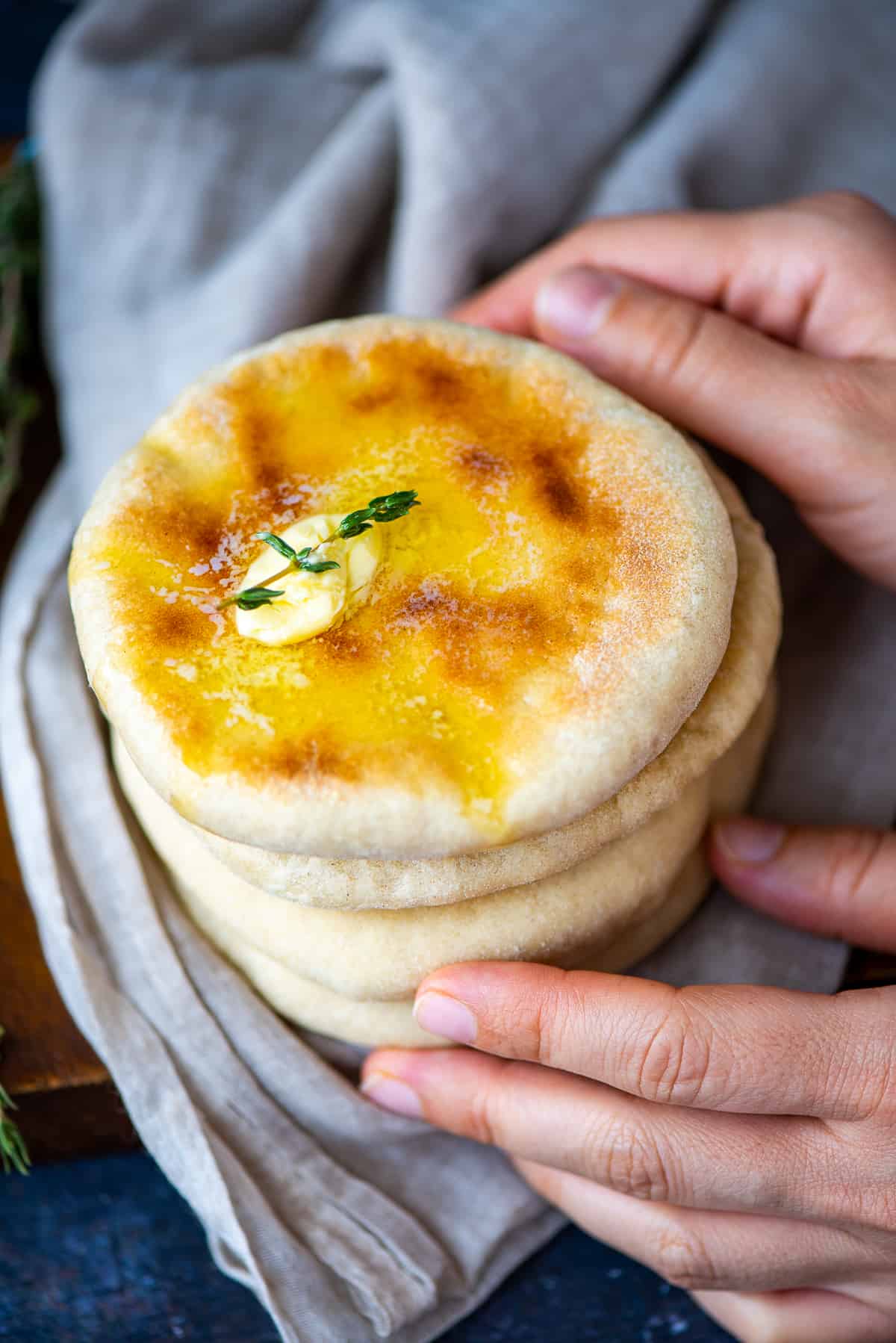
In our family, bazlama holds a special place as a favorite Turkish flat bread that we make quite often, especially for weekend breakfasts. It's soft, easy to make, and goes with many foods. Making this simple bread has become a fun family tradition that reminds us of our heritage.
What Is Flatbread In Turkey?
Flatbreads are a type of bread made with flour, water, and salt, rolled out into a flattened dough and cooked on a hot surface. They are a staple in many cultures worldwide, including the Middle East, South Asia, and the Mediterranean.
Turkey is famous for its diverse range of flatbreads, with bazlama being just one of them. Some well-known Turkish flatbread recipes we shared on Give Recipe include:
- Lavash bread: A thin, soft bread often used as a wrap or served alongside dips and meze.
- Ramadan pide bread: A thick, round bread with a unique pattern on top, traditionally consumed during the month of Ramadan.
- Turkish pide pizza: A boat-shaped pizza topped with a variety of ingredients like cheese, meat, and vegetables.
- Lahmacun: A thin, crispy flatbread topped with minced meat, tomatoes, and spices, sometimes referred to as "Turkish pizza."
- Gozleme: A stuffed flatbread filled with ingredients such as cheese, spinach, or minced meat, cooked on a griddle.
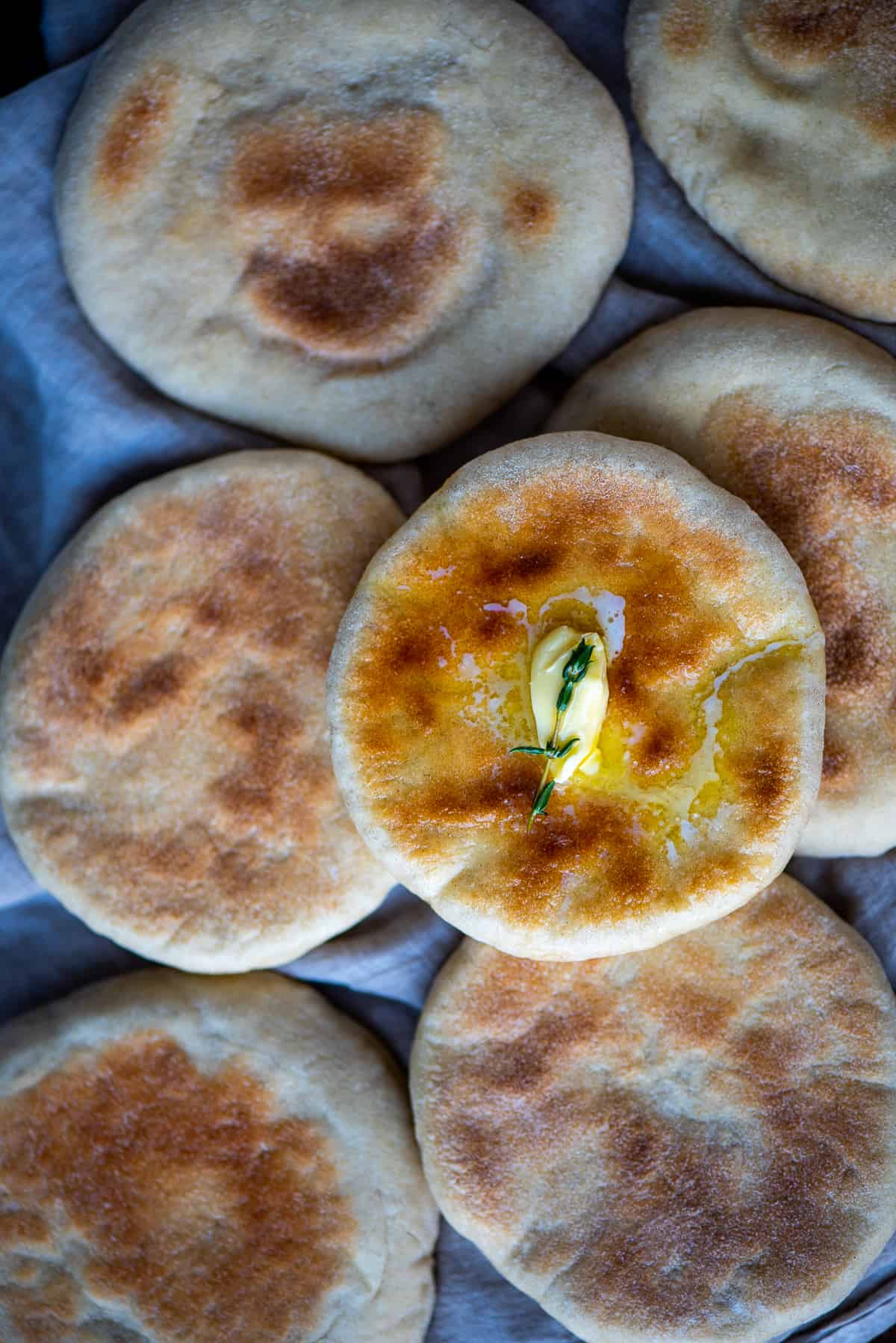
What is Bazlama?
Bazlama is another popular Turkish flatbread that is similar to naan bread and pita bread. It is even known as Turkish pita bread or Turkish naan around the world.
Bazlama is known as the best flat bread for breakfast in Turkey and a star on the table at kebab restaurants.
This delightful and easy-to-prepare bread is soft and chewy, with a slightly golden exterior, making it perfect for a wide variety of dishes. It is mostly identified as a "village bread" because of the simple ingredients needed and the cooking method.
Traditionally, in Turkish villages, bazlama is cooked using a simple yet authentic method. Instead of modern stoves or ovens, the villagers prepare the bread on a "sac," which is a large, dome-shaped metal griddle or a convex clay or stone surface. The sac is placed over a wood fire, providing consistent heat for the bread to cook.
Of course, you don't need to follow the traditional village method to enjoy delicious bazlama at home. This versatile Turkish flatbread recipe can easily be made using a non-stick pan or a cast iron skillet on your stovetop.
Ingredients & Substitutions
One of the appealing aspects of our bazlama recipe is the simplicity of its ingredients, most of which are commonly found in your kitchen pantry. Here's a breakdown of each ingredient and its role in this delicious Greek yoghurt flatbread recipe, along with possible substitutions:
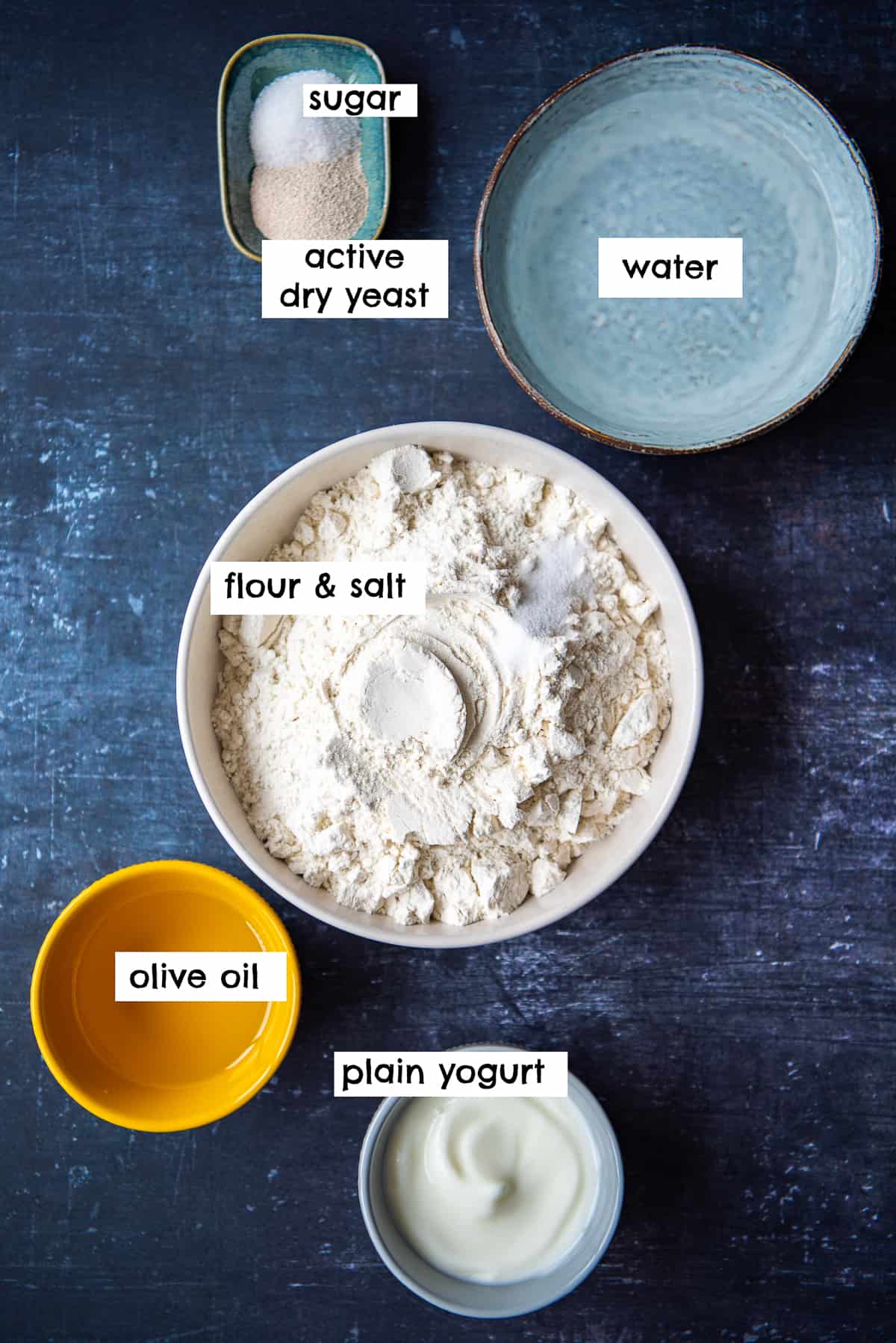
- Active dry yeast: Responsible for making the dough rise, creating the soft, airy texture. An alternative is using instant dry yeast, which can be mixed in the dry ingredients. Check out the difference between active dry yeast and instant yeast to learn more.
- Sugar: A small amount of sugar helps activate the yeast by providing it with food to grow.
- Lukewarm water: It has a temperature range of about 100°F to 110°F (38°C to 43°C). It should feel warm to the touch but not hot, as water that is too hot can kill the yeast and prevent the dough from rising properly.
- All-purpose flour: The primary component of the dough, providing structure and chewiness. You can substitute it with whole wheat flour or a blend of both for a healthier option, but keep in mind that whole wheat flour absorbs more liquid, so adjust accordingly.
- Salt: Enhances the flavor of the bread.
- Yogurt: Use plain Greek yogurt. It adds a slight tanginess and moisture to the dough, contributing to the soft texture. You can substitute it with an equal amount of buttermilk or a mixture of milk and a small amount of vinegar or lemon juice.
- Olive oil: Provides richness and moisture to the dough, making it easier to work with and imparting a subtle flavor. Other vegetable oils or melted butter can also be used as alternatives.
How To Make It
Creating delicious bazlama at home is a simple process that involves a few key steps. Here is our easy recipe for this Turkish flat bread:
Prepare The Dough
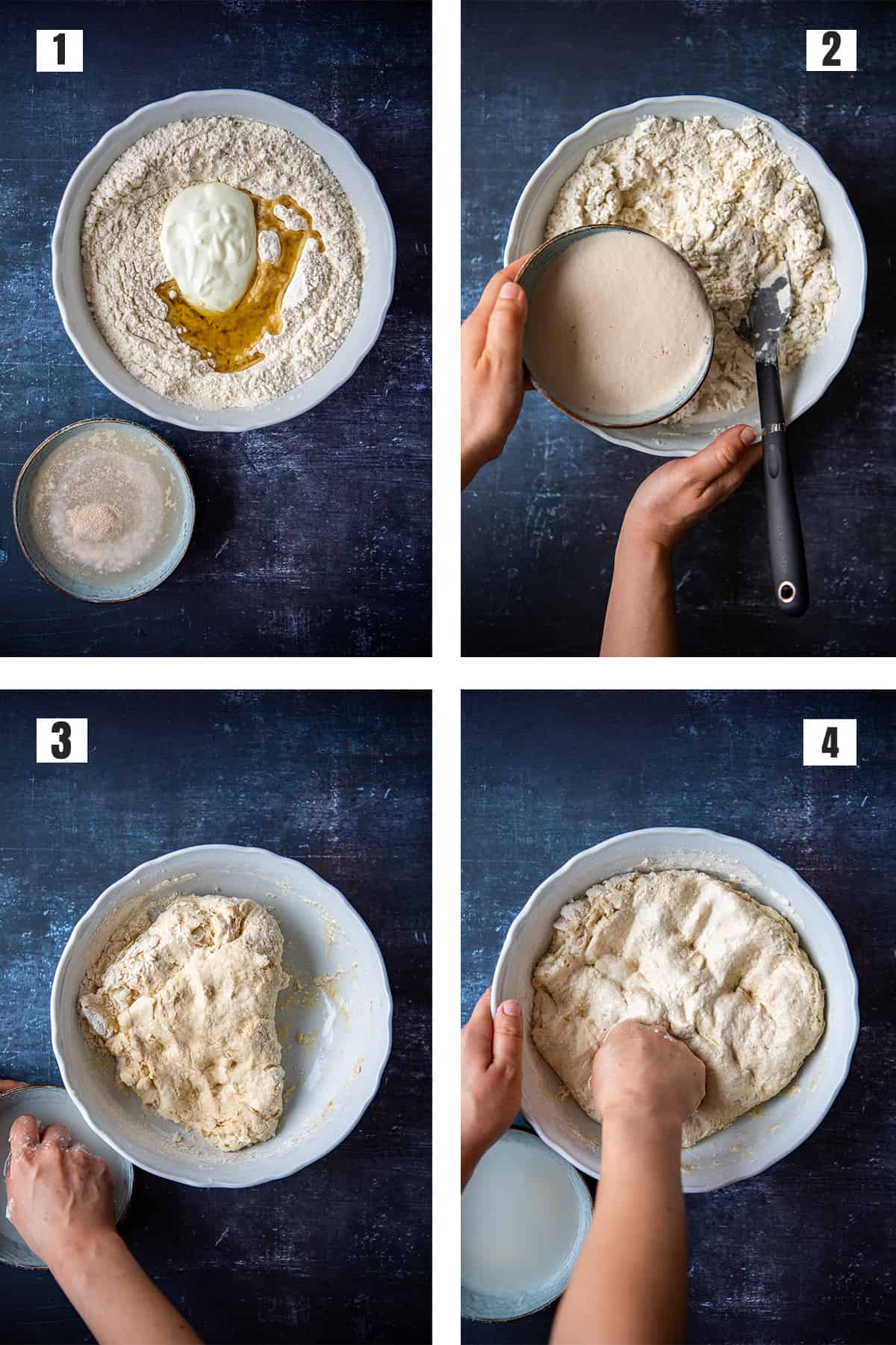
- In a medium-sized bowl, whisk together the active dry yeast, sugar, and lukewarm water. Allow the mixture to sit for about 5 minutes in a warm place for proofing.
- In a large bowl, whisk together the all-purpose flour and salt.
- Add yogurt and olive oil to the flour and salt mixture. Stir well with a spatula.
- Pour the yeast mixture into the large bowl and combine everything well with your hand. Keep ¼ cup water in a bowl on the side and wet your hand if the dough gets too sticky.
- Knead the dough in the bowl for 3-4 minutes until everything holds together, forming a soft and slightly sticky dough.
- Cover the bowl with plastic wrap and let the dough sit in a warm place for about 45-60 minutes, or until doubled in size.
Shape The Dough

- Sprinkle some flour on the counter, transfer the dough onto it, and knead for about 5 minutes to remove any air. Dust your hands with flour to prevent sticking.
- Form a large log with the dough and cut it into equal pieces – 12 pieces for small flatbreads or 6 pieces for larger ones.
- Roll each piece of dough into a ball, folding the edges to the center and rolling them in your palm to create a smooth shape.
- Place the dough balls on a floured surface and cover them with a kitchen towel to prevent drying.
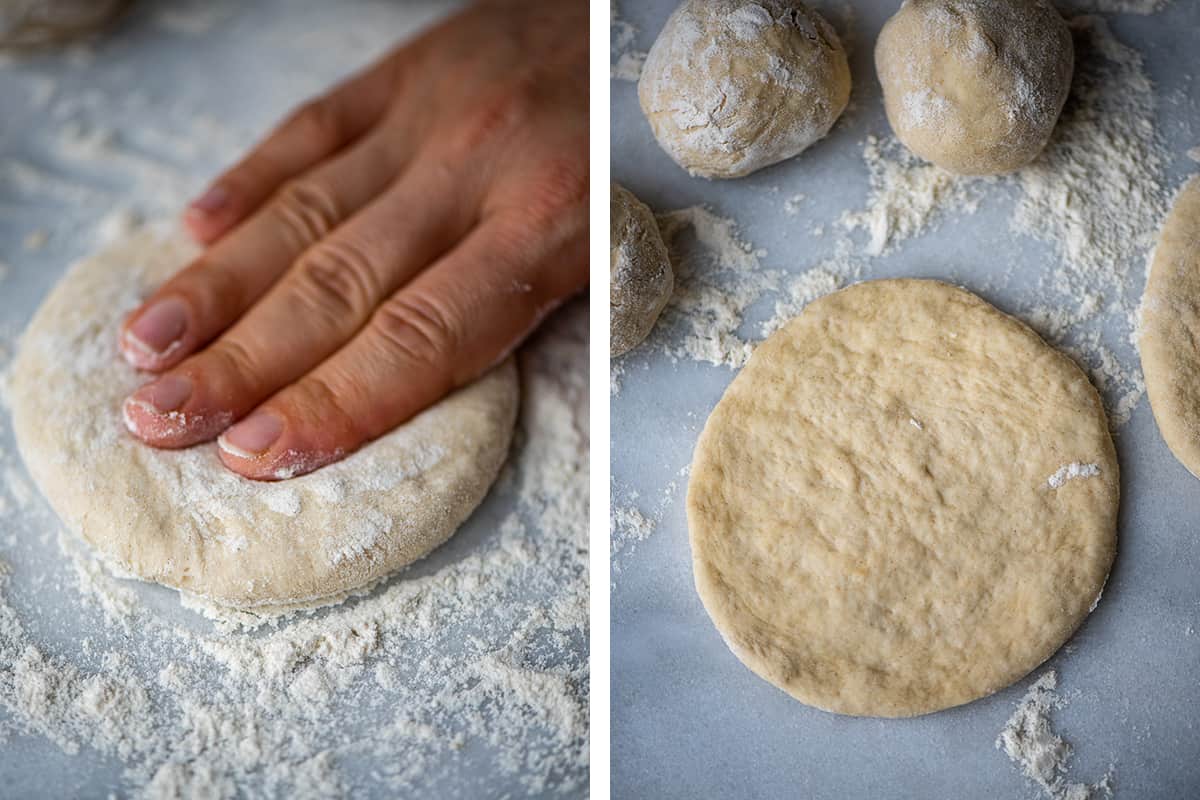
- One at a time, place a dough ball on a floured surface and flatten it using your middle three fingers or a rolling pin, aiming for a thickness of about 1 inch (2.5 cm).
Cook The Bread
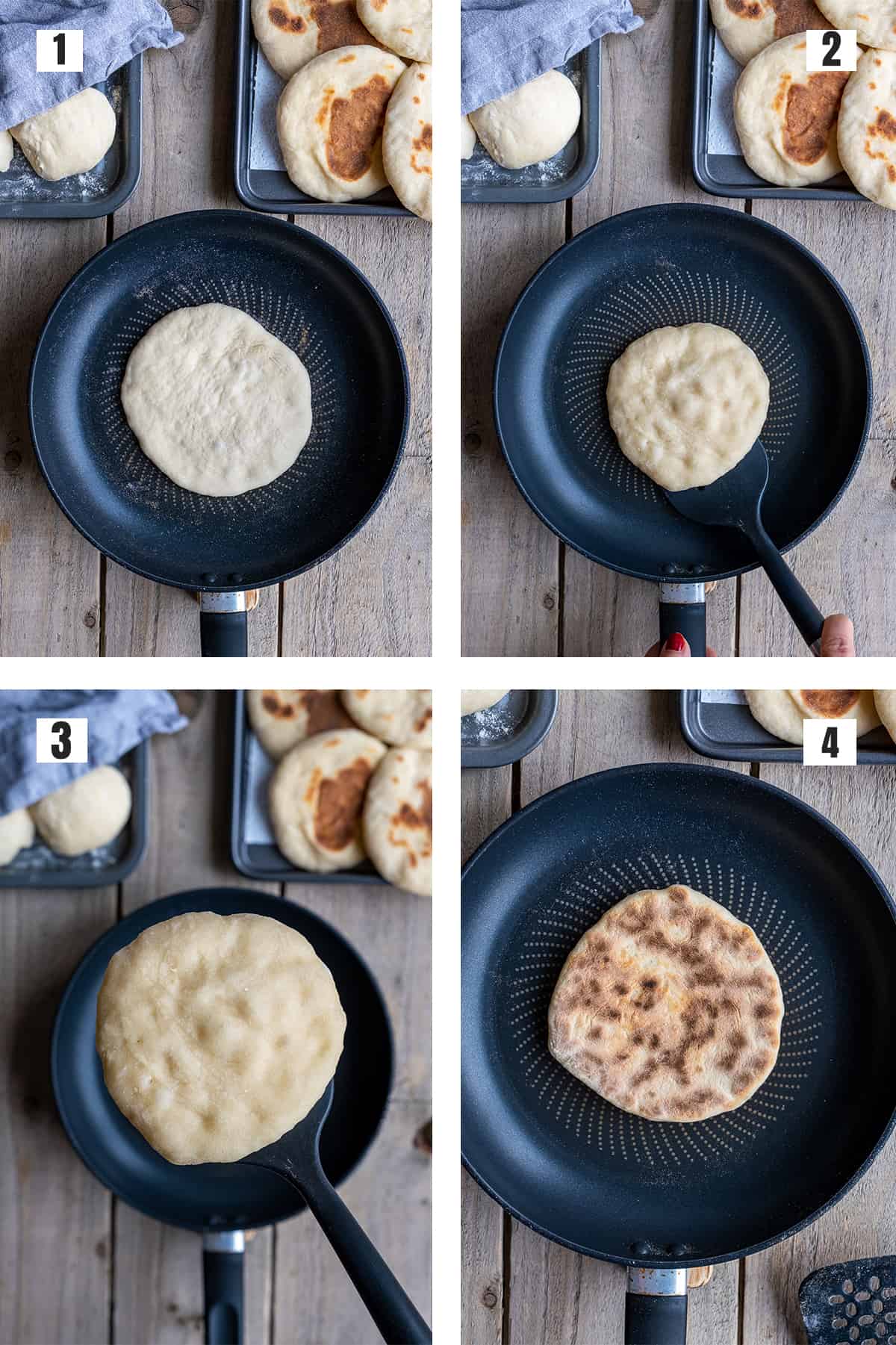
- Heat a non-stick pan over medium-high heat and place the flattened dough onto the pan.
- Cook each dough for about 90 seconds, or until small bubbles appear on the top. Check the underside with a spatula – when you see brown spots, flip the bread and cook the other side for about 1 minute.
- Once cooked, place the flatbread in a large kitchen towel to keep it soft and prevent drying.
- Repeat this process for the remaining dough balls, cleaning the pan with a paper towel after cooking 3-4 flatbreads to remove any burnt flour.
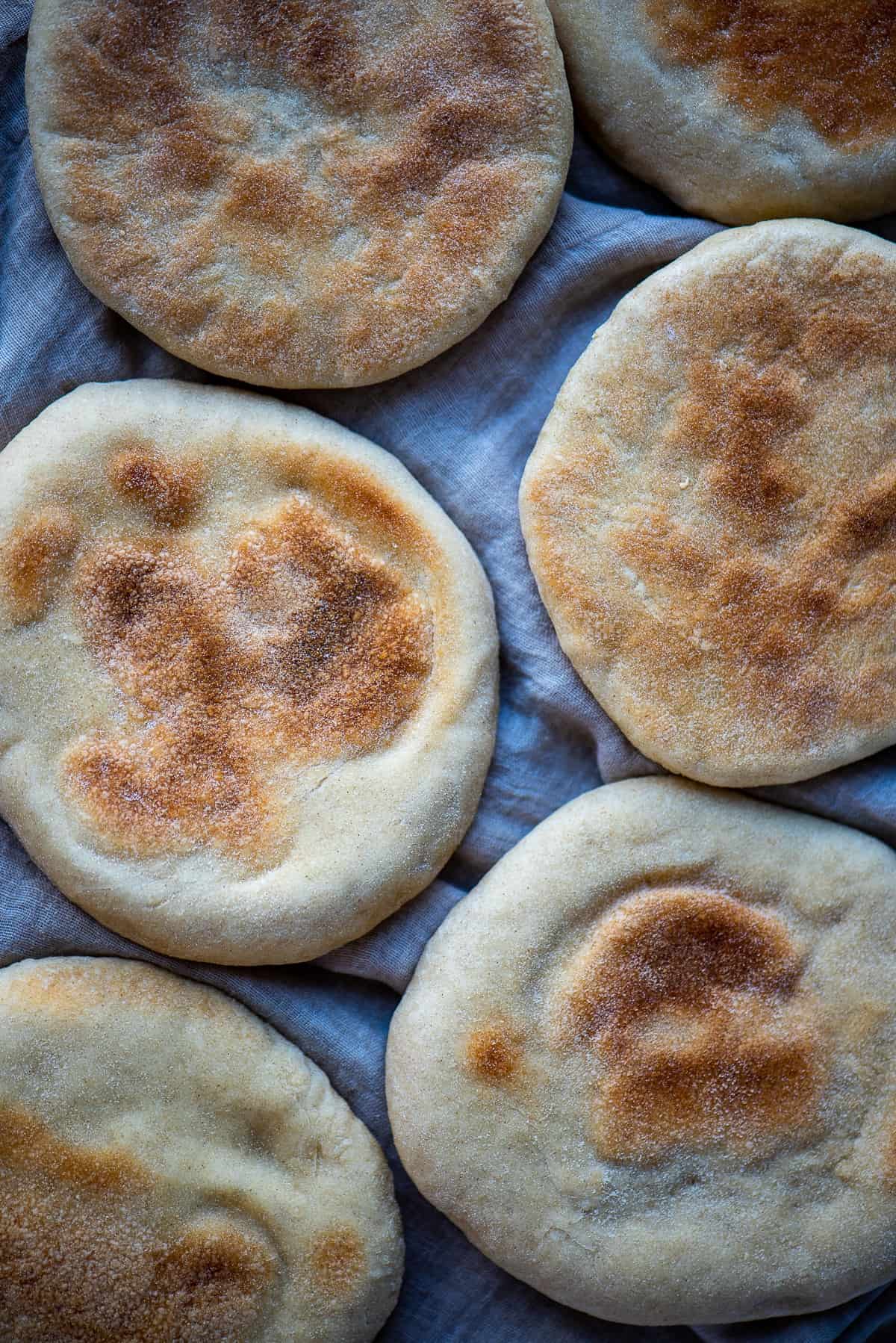
Important Tips
- Yeast activation: Make sure the water used to activate the yeast is lukewarm, neither too hot nor too cold. Water that is too hot can kill the yeast, while water that is too cold may not activate it properly. The ideal temperature range for lukewarm water is about 100°F to 110°F (38°C to 43°C).
- Kneading the dough: If the dough is too sticky, wet your hands with a little water rather than adding more flour, which can make the bread denser. Remember this is supposed to be a soft dough.
- Rising time: Be patient and allow the dough to rise until it doubles in size. The time needed for rising can vary depending on the ambient temperature, so keep an eye on the dough and adjust the rising time accordingly.
- Shaping the dough: When shaping the dough balls and flattening them, dust your hands and work surface with flour to prevent sticking. However, use only a minimal amount of flour to avoid making the bread too dry.
- Cooking temperature: Monitor the heat level while cooking the bread. If the pan is too hot, the bread might burn on the outside before the inside is fully cooked. Conversely, if the heat is too low, the bread may not puff up properly and could become dry. Adjust the heat as needed throughout the cooking process.
- Cleaning the pan: After cooking 3-4 flatbreads, clean the pan with a piece of paper towel to remove any burnt flour left. This helps maintain an even cooking surface and prevents any burnt taste from transferring to the remaining flatbreads.
Storing & Reheating
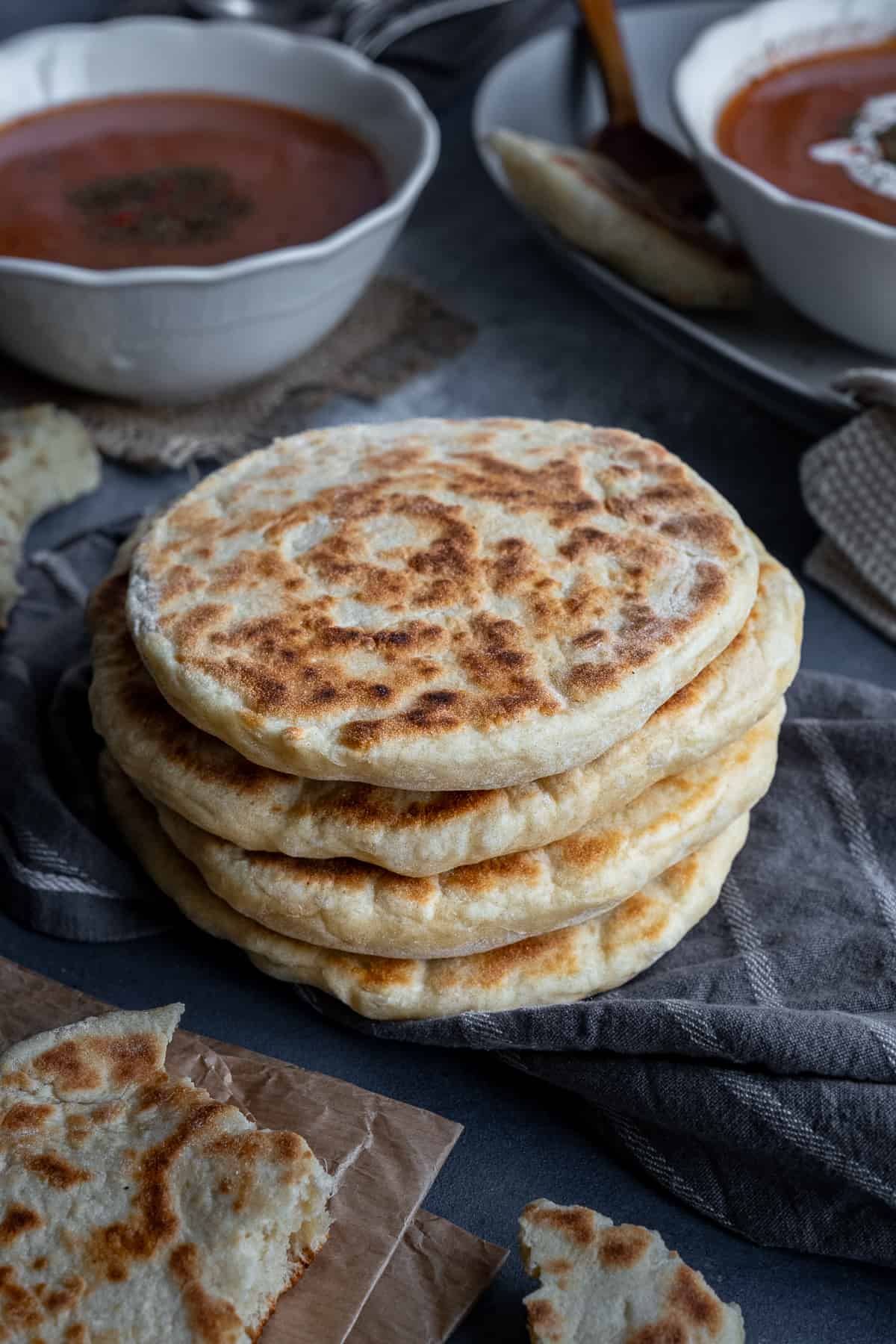
Proper storage and reheating of this simple bread can ensure that it remains soft and flavorful, even as leftovers. Here's how to store and reheat Bazlama effectively:
Storing:
- Once they have cooled, wrap the flatbreads in a clean kitchen towel to keep them soft and prevent drying out.
- Transfer the wrapped flatbreads to an airtight container or sealable plastic bag.
- Store at room temperature for up to 2 days. For longer storage, place the container or bag in the refrigerator for up to a week.
Reheating:
- Reheat it in a skillet or non-stick pan over low heat, flipping occasionally, until warmed through.
- Alternatively, you can reheat them in the oven: Preheat your oven to 350°F (175°C). Wrap it in aluminum foil to retain moisture during reheating.Place the wrapped flatbreads on a baking sheet and heat them in the oven for 5-10 minutes, or until they are warmed through.
Serving Suggestions
Bazlama is a versatile Turkish bread that can be enjoyed in various ways. Here are some popular serving suggestions:
Traditional Turkish Breakfast: Bazlama is a favorite at Turkish breakfast tables, where it's often served alongside dishes like menemen (a tomato and pepper dish with eggs), Turkish eggs, butter, honey, crumbled feta cheese or grilled halloumi cheese, black and green olives, and assorted jams (our favorite is mulberry jam) and Turkish tea. This combination provides a delightful mix of flavors and textures to start the day.
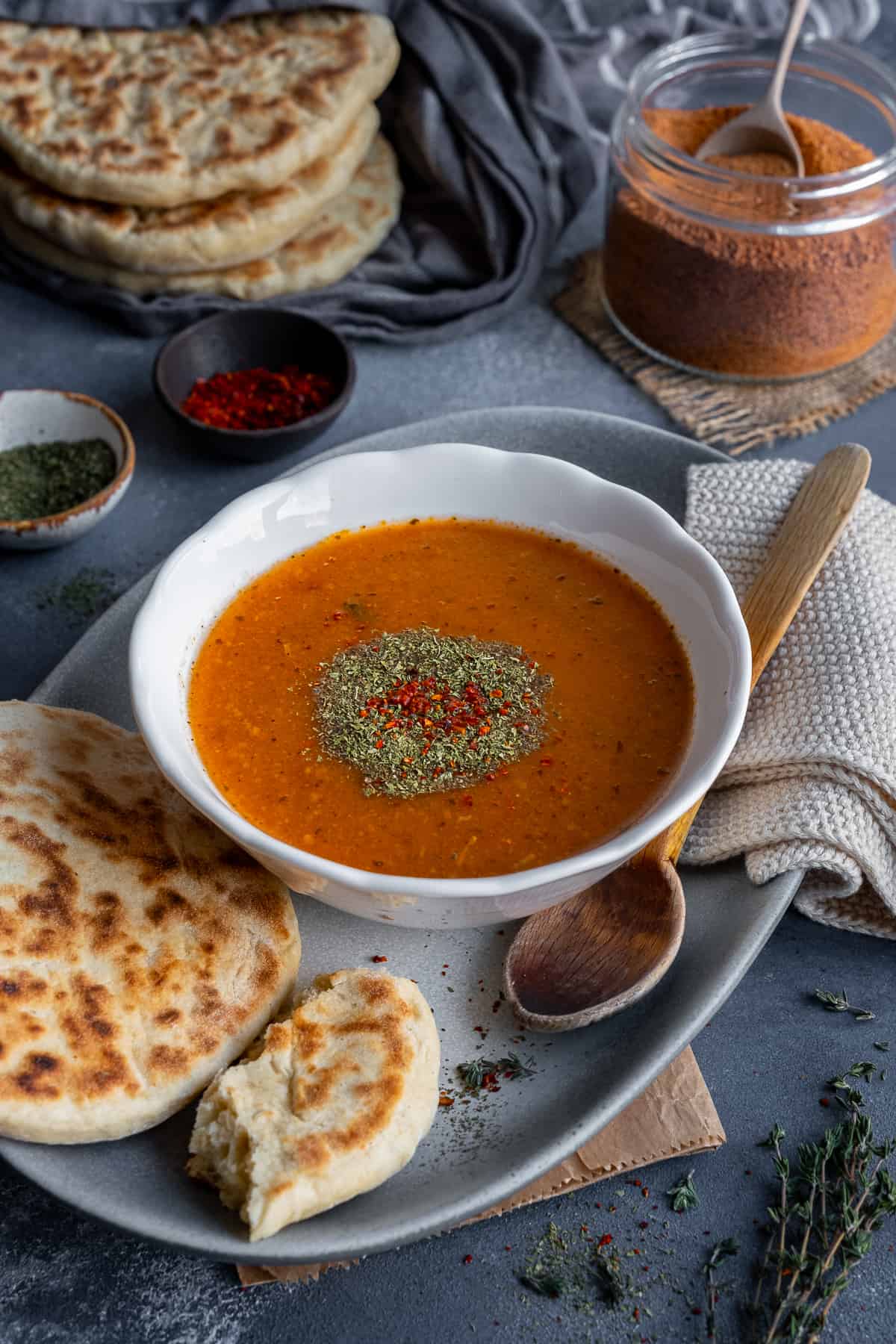
Soups: Serve it with your favorite soups, whether it's a hearty Turkish lentil soup, ezo gelin corba, or yogurt soup, a tomato-based soup like roasted garlic tomato soup, or a comforting bowl of chicken or old fashioned cabbage soup. The bread adds a deliciously soft and chewy texture to the meal.
Sandwiches and Wraps: Use it as a base for sandwiches and wraps. Fill the pocket inside it with your choice of meats, cheeses, vegetables, and sauces. For example, try a doner kebab or Adana kebap with lettuce, tomato, and garlic sauce or a veggie wrap with hummus, cucumber, and roasted red peppers.
Dips and Spreads: It pairs well with various dips and spreads. Serve it with a bowl of extra virgin olive oil flavored some herbs or classic Mediterranean favorites such as Turkish hummus, no tahini baba ganoush, tzatziki, ezme sauce, or muhammara. You can also try it with regional Turkish dips like cacik (a yogurt, cucumber, and mint dip) or haydari (a thick yogurt dip with feta cheese, garlic and herbs).
Accompaniment for Main Courses: Use it to soak up the delicious sauces and juices from main dishes like Turkish lamb stew, kuru fasulye (bean stew), guvec (Turkish beef stew), meatball stew, kapuska (cabbage stew) or izmir kofte (Turkish meatballs in tomato sauce). The bread's soft texture is perfect for savoring every last bit of flavor.
Dessert: For a sweet treat, spread warm bazlama with butter and sprinkle it with a mixture of sugar and cinnamon or drizzle of honey and chopped nuts.
Variations
This is a versatile Turkish flat bread recipe and it can be adapted to suit different tastes and preferences. Here are some popular variations that you can try:
- Make It With Whole Wheat: For a more wholesome and nutritious option, replace a portion or all of the all-purpose flour with whole wheat flour. This will result in a denser texture and a slightly nuttier flavor.
- Make It Herb-infused: Enhance the flavor of your bazlama by adding fresh or dried herbs to the dough. Popular choices include dill, parsley, thyme, or rosemary. You can also add spices like cumin or nigella seeds for an extra kick.
- Make It Stuffed: Transform bazlama into a satisfying meal by adding a filling. Spread a layer of your favorite filling, such as spiced ground beef, cheeses like feta, mozzarella, or Turkish white cheese, borek fillings like spinach and feta, on half of the rolled-out dough. Fold the other half over the filling, press the edges together, and cook as instructed.
- Make It Gluten-free: For those with gluten sensitivities, substitute the all-purpose flour with a gluten-free flour blend. You may need to adjust the liquid content and kneading time to achieve the desired dough consistency.
- Make It Vegan: Replace the yogurt with a plant-based alternative like soy or coconut yogurt or almond milk buttermilk.
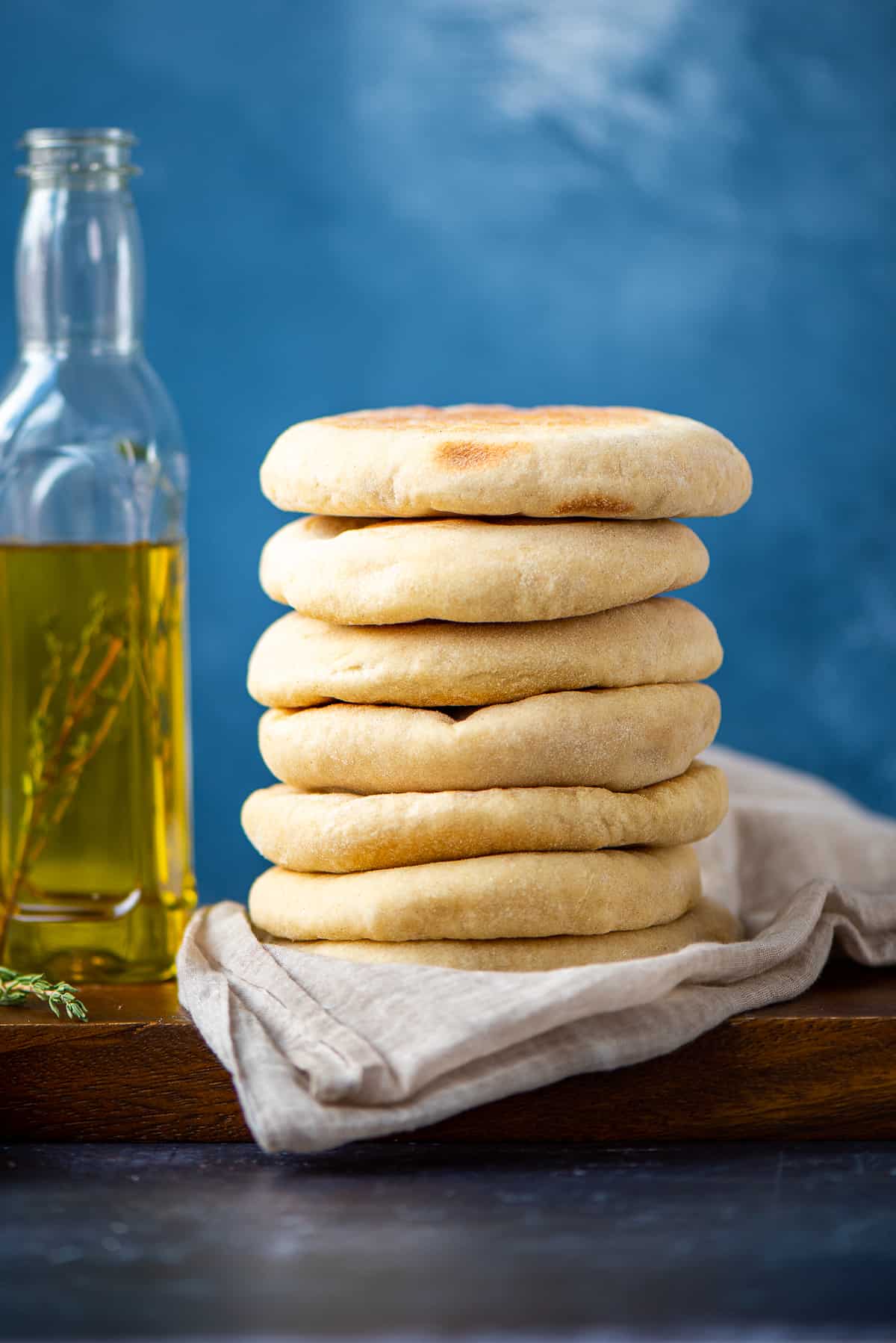
FAQs
While bazlama shares some similarities with naan and pita, there are differences in ingredients and preparation methods. Bazlama incorporates yogurt in the dough, giving it a distinct flavor and texture. Additionally, it is typically thicker than pita and has a softer texture compared to naan.
Yes, you can use instant yeast in place of active dry yeast. Instant yeast doesn't require proofing with sugar and warm water; simply mix it directly into the flour. The rising time might be slightly shorter with instant yeast.
Yes, you can freeze it. Wrap each flatbread individually in plastic wrap, then place them in a sealable plastic bag or airtight container. Freeze for up to three months. To reheat, let the flatbread thaw at room temperature before following the reheating instructions provided earlier.
Absolutely! You can prepare the dough in advance, cover it with plastic wrap, and store it in the refrigerator for up to 24 hours. Before shaping and cooking the flatbreads, let the dough come to room temperature.
If you don't have a non-stick pan, you can use a cast-iron skillet, a griddle, or a regular frying pan. Just make sure to lightly grease the surface with oil or butter to prevent the flattened dough from sticking.
Other Bread Recipes
Other Turkish Recipes
As always: If you make this recipe, let us know what you think by rating it and leaving a comment below. And post a pic on Instagram too—tag @give_recipe so we can see!
Sign up for the FREE GiveRecipe Newsletter to get the new recipes into your inbox! And stay in touch with us on Facebook, Pinterest, YouTube and Instagram for all the latest updates.
Bazlama Bread Recipe
This Bazlama recipe will guide you through creating a delicious Turkish flatbread that is soft, slightly chewy, and versatile. Made with simple ingredients like flour, yogurt, and olive oil, Bazlama is perfect for breakfast, sandwiches, or as an accompaniment to your favorite dishes. Follow the step-by-step instructions to make your own Bazlama and enjoy its delightful flavor and texture in a variety of ways!
- Prep Time: 1 hour 30 minutes
- Cook Time: 25 minutes
- Total Time: 2 hours
- Yield: 12 1x
- Category: Bread
- Method: Cooking
- Cuisine: Turkish
Ingredients
- 2 teaspoons active dry yeast
- 1 teaspoon sugar
- 250 ml lukewarm water, plus ¼ cup to wet hands when kneading the dough
- 500 g (3 and ¾ cups) all purpose flour, plus ¼ cup for kneading and shaping
- 1 teaspoon salt
- 110 ml Greek style yogurt
- ¼ cup olive oil
Instructions
- Prepare the yeast: In a medium-sized bowl, whisk the yeast together with sugar and warm water. Let it sit for about 5 minutes for proofing in a warm place.
- Prepare the dry ingredients: In a large bowl, whisk together the flour and salt in a large bowl.
- Make the dough mixture: Add yogurt and olive oil in the flour and salt mixture. Stir it well with a spatula. Pour the yeast mixture and combine everything well with your hand until no flour lumps left. Keep ¼ cup water in a bowl on the side to wet your hand whenever you feel the dough is too sticky. Knead it in the bowl for 3-4 minutes or until everything holds well together. You will get a soft and slightly sticky dough. Finally, tap the surface of the dough with wet hands.
- Rise the dough: Cover the bowl with plastic wrap and let it sit in a warm place for about 45-60 minutes or until it is doubled in size.
- Portion the dough: Sprinkle some flour on the counter, transfer the dough on it and knead for about 5 minutes to remove the air inside it. Dust your hands with flour to prevent sticking. Then make a big log from it and cut it in equal pieces. We make 12 pieces for small flat breads. If you want them larger, cut it into 6 pieces.
- Make dough balls: Roll each piece of dough into a ball. Fold the edges to the center, then roll in your palm and give it a ball shape. Dust your hand with flour if needed. Put them on a floured surface and cover all the dough balls with a kitchen towel so that they don’t dry out.
- Shape the dough balls: Grab one ball and place it on a floured surface. Flatten it by using your middle three fingers on it a few times, flip it over and continue flattening by pressing your fingers on it (or use a rolling pin). The thickness will be about 1 inch / 2,5 cm.
- Cook bazlama bread: Heat a non stick pan over medium high heat and put the flattened dough on it. While it is cooking, roll another dough out. Each time you place a rolled out dough in the pan, shape another one. So when it is cooked, the other will be ready to be placed in the pan. Let it cook for about 90 seconds or until you see small bubbles on the top. Check the underside using a spatula. If you see brown spots, it is time to flip. Cook the other side about 1 minute or until you see brown spots on that side too. Put the cooked flatbread in a large kitchen towel to keep it soft and prevent it from drying.
- Repeat: Place the second dough in the pan and while it is cooking, shape another one. After cooking 3-4 flatbreads, clean the pan with a piece of paper towel to remove the burnt flour in the pan and then continue cooking the dough balls.
Notes
- Ensure the water for yeast activation is lukewarm (100°F to 110°F or 38°C to 43°C).
- Knead the dough well, using water to combat stickiness.
- Allow the dough to rise until doubled in size.
- Use minimal flour when shaping the dough to avoid dryness.
- Monitor and adjust the heat level while cooking the bread.
- Clean the pan with a paper towel after cooking 3-4 flatbreads to remove burnt flour.
- Wrap cooked bazlama in a kitchen towel for softness and proper storage.
- Transfer the wrapped flatbreads to an airtight container or sealable plastic bag. Store at room temperature for up to 2 days. For longer storage, place the container or bag in the refrigerator for up to a week.
- Reheat it in a skillet or non-stick pan over low heat, flipping occasionally, until warmed through.
Please read the Important Tips section above for more details.
Nutrition
- Serving Size:
- Calories: 206
- Sugar: 0.9 g
- Sodium: 199.7 mg
- Fat: 5.7 g
- Carbohydrates: 32.9 g
- Protein: 5.6 g
- Cholesterol: 1.4 mg
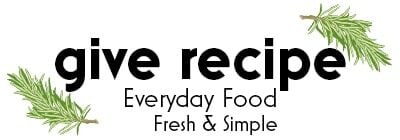

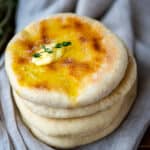
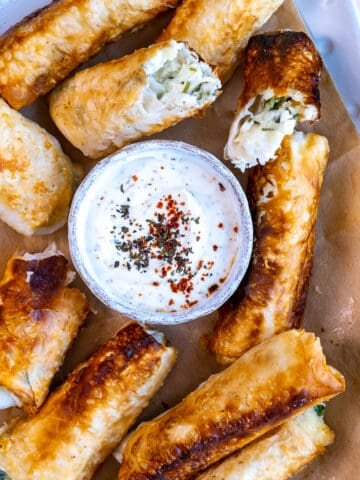
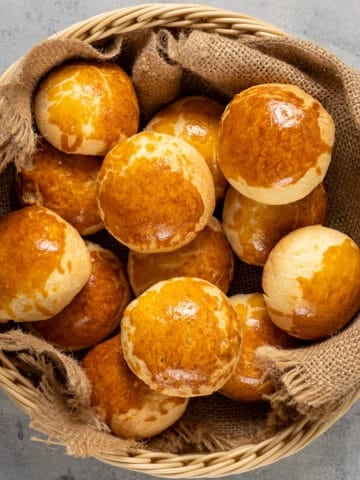
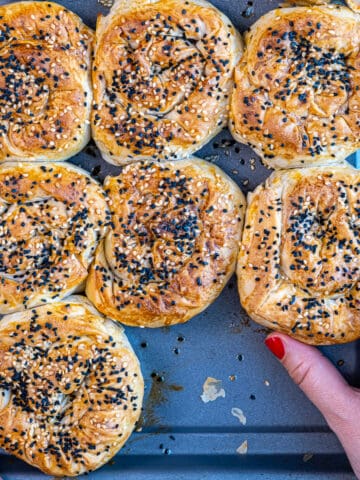
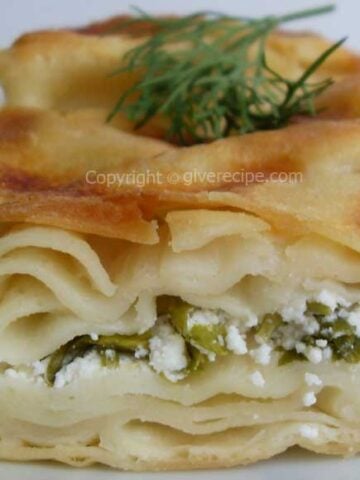
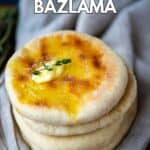
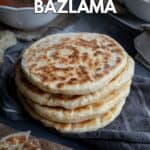
Jen says
I made these with freshly ground Kamut flour, and they were light and delicious. The yogurt gives a great tang. Thanks for the great recipe.
Zerrin & Yusuf says
Hi Jen,
Most welcome! Happy to hear that you enjoy our bazlama recipe.
We have never tried Kamut flour. Thank you for sharing your experience with us here. Yogurt helps the softness as well.
Jen says
Kamut is an "ancient" grain that's grown in my state. It is absolutely delicious and sweet and nutty. It has very little gluten, so its a bit more delicate than whole wheat or white flour.
That's interesting about yogurt. I bake a lot of bread, but this is the first time with yogurt. I'll definitely try it again in other breads, just to experiment. Thanks a lot for your beautiful blog. I have a list of recipes to try.
LeighAnne says
I had a bread similar to this that the Navajo made and they gave it to me with a scoop of buffalo chili with onions & cheese on it at a pow-wow, this is the closest I have seen to that bread and if it can be cooked over an open fire it I will have to try it because it was the best thing I have ever eaten in my life
How do you cook it over a wood fire? Do you always make this the same way or do you ever add different flavors /herbs etc. To give it a different taste?
Zerrin & Yusuf says
Hi LeighAnne,
We have never tried it over a wood fire but saw several times that people in the countryside make it over an open wire. They put a thin iron plate over the fire and cook the breads on it.
We normally enjoy this flatbread plain, but you can absolutely flavor it with herbs(green onions) or seeds (sesame seeds).
Niall says
Hi guys,I'd live to make these,but at a Lisa owing to the metric system!!!!how much flour in grams please???
Zerrin & Yusuf says
Hi Niall,
We didn't measure it in grams but the cup we use is 200ml. The dough will be soft and a bit sticky after everything is combined well. But you will sprinkle flour when flattening the dough balls. Just practice and will see you are getting better.
LeighAnne says
490 grams that the recipe calls for(3-1/2cups) and extra 70 grams for extra (1/2 c).
Helen Ertürk says
The recipe looks easy and tasty.....How long do I leave the dough for the 2nd rise please? If using a stand mixer for the initial kneading, should I add the extra water that is used for hand kneading?
Yusuf says
Hi Helen,
Thanks for asking this. You can let them sit for 15 minutes. When you are cooking one or two patties in a pan, the others will continue resting under the damp cloth. So please don't uncover them to prevent them from drying.
As for the extra water question, you will probably don't need it in a stand mixer. We wet hands when making the dough because it sticks and makes it harder otherwise.
Hope these help.
Nathalie says
Hi,
Can you freeze the Bazlama for a later date? We don't eat much bread in general but i love bazlama so would love to make and freeze if possible.
Thanks,
Nathalie
Zerrin & Yusuf says
Hi Nathalie,
Yes, you can freeze bazlama in zip-seal freezer bags. Then you can re-heat it in a pan over low heat when you are ready to eat.
Helen says
This recipe looks great. Can I use my mixer with dough hook for this recipe or is it better by hand?
Yusuf says
Thank you Helen! Yes, you can use your stand mixer with a dough hook.
Ximena says
Can I use kefir instead of yogurt
Yusuf says
Never tried it when making bazlama but I think you can substitute kefir for yogurt here. Just make sure it is at room temperature.
Faye Levy says
Looks so delicious, and I love the way you explained it!
Yusuf says
Glad you loved it Faye!
Aysegul says
WOW! I am literally drooling here. I can eat this every single day.
With your incredibly detailed and well written instructions, making bazlama was a breeze. Thank you!
Yusuf says
Glad you liked it! Bazlama is always a hit, isn't it?
Chris says
Which kind of yogurt is best for this? We have thick greek yogurt (plain) and regular plain yogurt that is thinner in our markets. This looks really good, and I'm ready to try it! Thank you!
Yusuf says
We use regular plain yogurt. Hope you love it as much as we do.
Joanne says
I am currently trying this recipe out...ive mixed up the ingredients and waiting for it to rise. I really hope it does as i tried a different recipe last night that was a disaster...I will be back with the result :))
Tony says
Thanks, easy to follow instructions I'll give it a go